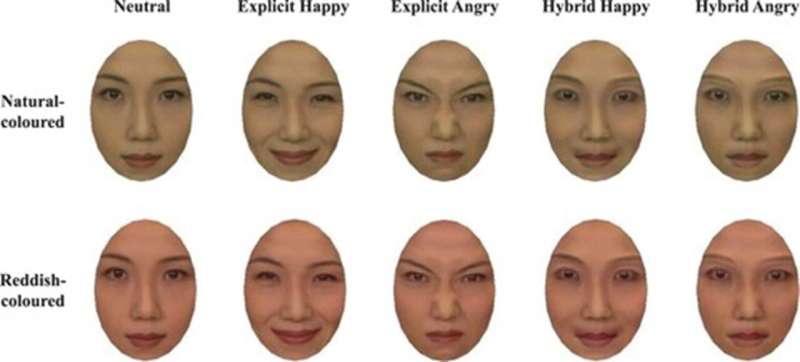
A research team in the Visual Perception and Cognition Laboratory and Cognitive Neurotechnology Unit of the Department of Computer Science and Engineering at Toyohashi University of Technology has conducted experiments to investigate the effects of facial color on implicit facial expression perception.
It is well-known that we associate reddish faces with happiness or anger, but their research explored whether facial coloring also affects how we subconsciously perceive emotions, those feelings of which we are not explicitly aware. In a recent study, the research team investigated how the color of a person’s face affects the way we see emotions even if we do not clearly realize these emotions. The results of this study were published in the journal Cognition and Emotion.
“Some previous research has shown that facial color modulates the recognition of facial expressions, such that the redder the face, the angrier the face appears. Furthermore, intergenerational, and cross-cultural comparisons suggest that the facial color effect may be influenced by language. Therefore, we suggest that facial color also influences implicit facial expressions,” explained Dr. Tetsuto Minami, who proposed the research idea.
In this study, the research team used special photos with mixed emotions referred to hybrid emotions, such as a little happiness or a little anger mixed with neutral emotions. In the first experiment, they found that these hybrid emotion photos were seen as neutral expressions. In the second experiment, they tested how friendly these mixed emotions seemed when the photos had different colors, including reddish and natural tones.
They discovered that reddish colors made happiness seem even friendlier, but it did not change how we saw angry expressions. In the third experiment, they confirmed that even with reddish colors, our brains still see these mixed emotions in a hidden way. Overall, their study shows that the color of a face can quietly affect how we perceive emotions, even when we are unaware of it.
The research team believes that research in psychology or in cognitive science is always interesting and highly applicable. Therefore, this research can be a premise for developing many useful future applications in diverse fields.
Hoang Nam Nguyen, the first author of the article, said, “Nowadays, technology has been developing fast with the strength of Artificial Intelligence (AI). However, it is difficult for AI devices to recognize hidden emotions on human faces. Even humans in everyday life have difficulties in recognizing those emotions. Our research hopes to be applicable in areas such as identifying employee attitudes in the company, supporting customer care, identifying criminal psychology.”
“We believe that with the rapid development of modern science and technology, such applications will quickly appear.”
However, these research results are only initial suggestions regarding the hypothesis about the impact of facial color on hidden emotions. The research team believes that more tests still need to be done to further support this argument. In addition, investigating different groups with different backgrounds is also necessary.
More information:
Hoang Nam Nguyen et al, The effect of facial colour on implicit facial expressions, Cognition and Emotion (2023). DOI: 10.1080/02699931.2023.2258575
Journal information:
Cognition and Emotion
Source: Read Full Article


